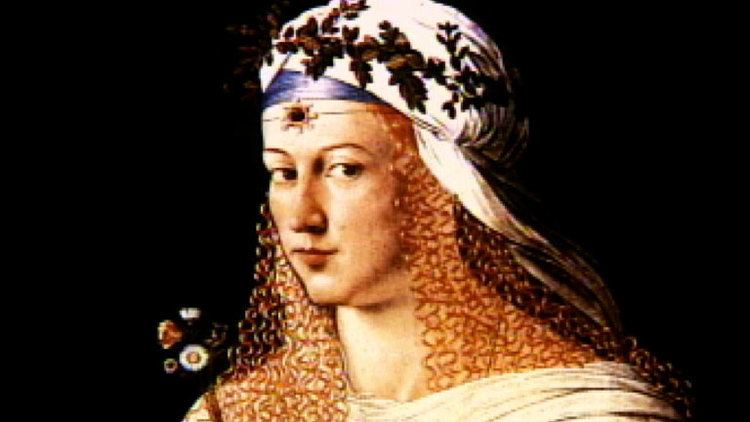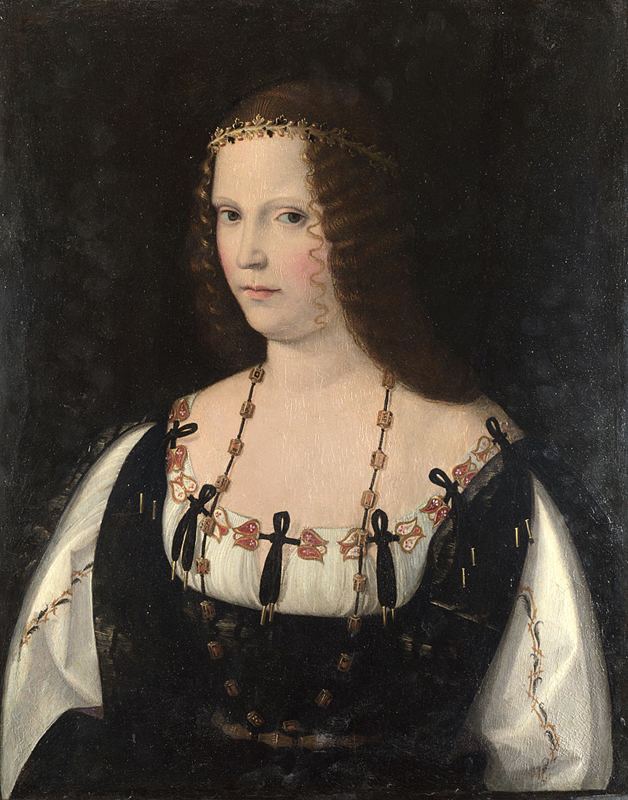 | ||
Born 18 April 1480, Subiaco, Italy ( 1480-04-18 ) Spouse Alfonso I d'Este, Duke of Ferrara (m. 1502–1519), Alfonso of Aragon (m. 1498–1500), Giovanni Sforza (m. 1493) Similar Vannozza dei Cattanei, Cesare Borgia, Pope Alexander VI Died 24 June 1519 (aged 39) Ferrara, Duchy of Ferrara | ||
Lucrezia Borgia ([luˈkrɛttsja ˈbɔrdʒa]; Valencian: Lucrècia Borja [luˈkrɛsia ˈbɔɾdʒa]; 18 April 1480 – 24 June 1519) was the daughter of Pope Alexander VI and Vannozza dei Cattanei. Her brothers included Cesare Borgia, Giovanni Borgia, and Gioffre Borgia.
Contents
- Lucrezia Borgia The infamous Daughter of Pope Alexander VI Great Personalities of History
- Lucrezia Borgia 18 April 1480 24 June 1519
- Early life
- First marriage Giovanni Sforza
- Alleged affair with Perotto
- Second marriage Alfonso dAragon Duke of Bisceglie
- Third marriage Alfonso dEste Duke of Ferrara
- Appearance
- Rumours
- Issue
- Biographies
- In Fiction
- References
Her family arranged several marriages for her that advanced their own political position including Giovanni Sforza (Lord of Pesaro), Alfonso of Aragon (Duke of Bisceglie), and Alfonso I d'Este (Duke of Ferrara). Tradition has it that Alfonso of Aragon was an illegitimate son of the King of Naples and that her brother Cesare may have had him murdered after his political value waned.
Rumors about her and her family cast Lucrezia as a femme fatale, a role in which she has been portrayed in many artworks, novels and films.

Lucrezia Borgia: The infamous Daughter of Pope Alexander VI - Great Personalities of History
Lucrezia Borgia 18 April 1480 – 24 June 1519
Early life

Lucrezia Borgia was born at Subiaco, near Rome. Her mother was Vannozza dei Cattanei, one of the mistresses of Lucrezia's father, Rodrigo Borgia (Pope Alexander VI). Lucrezia Borgia's education was entrusted to Adriana Orsini de Milan, a close confidant of Cardinal Rodrigo Borgia (Pope Alexander VI) during her early life. Her education would primarily take place in the Piazza Pizzo de Merlo, a building adjacent to her fathers residence. Her education is common for a woman of her social stature, but uncommon for someone of her gender. Unlike educated women of her time, hers came from within the sphere of intellectuals in court and close relatives. For most women who wanted to be educated, convents were the primary source for knowledge. Her upbringing would differentiate to others due to the inclusion of Humanities, which the Catholic Church at the time considered detrimental to the foundations of piety and obedience. This education would be successful in teaching Lucrezia; Spanish, Catalan, Italian, French, and some dominance of Latin and Greek. She would also become proficient in the lute, poetry, and oration. The biggest testament is her capability in administration, as later on in life she would take care of Vatican City correspondence and governance of Ferrara.
First marriage: Giovanni Sforza

On 26 February 1491, a matrimonial arrangement was drawn up between Lucrezia and the Lord of Val D'Ayora in the kingdom of Valencia, Don Cherubino Joan de Centelles, which was annulled less than two months later in favour of a new contract engaging Lucrezia to Don Gaspare Aversa, count of Procida. When Rodrigo became Pope Alexander VI, he sought to be allied with powerful princely families and founding dynasties of Italy. As such, he called off Lucrezia's previous engagements and arranged for her to marry Giovanni Sforza, a member of the House of Sforza who was Lord of Pesaro and titled Count of Catignola. Giovanni was an illegitimate son of Costanzo I Sforza and a Sforza of the second rank. He married Lucrezia on 12 June 1493 in Rome.
Before long, the Borgia family no longer needed the Sforzas, and the presence of Giovanni Sforza in the papal court was superfluous. The Pope needed new, more advantageous political alliances, so he may have covertly ordered the execution of Giovanni: the generally accepted version is that Lucrezia was informed of this by her brother Cesare, and she warned her husband, who fled Rome.
Alexander asked Giovanni's uncle, Cardinal Ascanio Sforza, to persuade Giovanni to agree to an annulment of the marriage. Giovanni refused and accused Lucrezia of paternal incest. The pope asserted that his daughter's marriage had not been consummated and was thus invalid. Giovanni was offered her dowry in return for his cooperation. The Sforza family threatened to withdraw their protection should he refuse. Giovanni finally signed confessions of impotence and documents of annulment before witnesses.
Alleged affair with Perotto
There has been speculation that during the prolonged process of the annulment, Lucrezia consummated a relationship with someone, perhaps Alexander's chamberlain Pedro Calderon, also named Perotto. In any case, families hostile to The Borgias would later accuse her of being pregnant at the time her marriage was annulled for non-consummation. She is known to have retired to the convent of San Sisto in June 1497 to await the outcome of the annulment proceedings, which were finalized in December of the same year. The bodies of Pedro Calderon, and a maid, Pantasilea, were found in the Tiber in February 1498. In March 1498, the Ferrarese ambassador claimed that Lucrezia had given birth, but this was denied by other sources. A child was born, however, in the Borgia household the year before Lucrezia's marriage to Alfonso of Aragon. He was named Giovanni but is known to historians as the "Infans Romanus".
In 1501, two papal bulls were issued concerning the child, Giovanni Borgia. In the first, he was recognized as Cesare's child from an affair before his marriage. The second, contradictory, bull recognized him as the son of Pope Alexander VI. Lucrezia's name is not mentioned in either, and rumors that she was his mother have never been proven. The second bull was kept secret for many years, and Giovanni was assumed to be Cesare's son. This is supported by the fact that in 1502 he became Duke of Camerino, one of Cesare's recent conquests, hence the natural inheritance of the Duke of Romagna's oldest son. Giovanni went to stay with Lucrezia in Ferrara after Alexander's death, where he was accepted as her half-brother.
Second marriage: Alfonso d'Aragon (Duke of Bisceglie)
Following her annulment from Sforza, Lucrezia was married to the Neapolitan Alfonso of Aragon, the half-brother of Sancha of Aragon who was the wife of Lucrezia's brother Gioffre Borgia. The marriage was a short one.
They were married in 1498; Lucrezia—not her husband—was appointed governor of Spoleto in 1499; Alfonso fled Rome shortly afterwards but returned at Lucrezia's request, only to be murdered in 1500.
It was widely rumored that Lucrezia's brother Cesare was responsible for Alfonso's death, as he had recently allied himself (through marriage) with France against Naples. Lucrezia and Alfonso had one child, Rodrigo of Aragon, who was born in 1499 and predeceased his mother in August 1512 at the age of 12.
Third marriage: Alfonso d'Este (Duke of Ferrara)
After the death of Lucrezia's second husband, her father, Pope Alexander VI, arranged a third marriage. She then married Alfonso I d'Este, Duke of Ferrara, in early 1502 in Ferrara. She had eight children during this marriage and was considered a respectable and accomplished Renaissance duchess, effectively rising above her previous reputation and surviving the fall of The Borgias following her father's death.
Neither partner was faithful: beginning in 1503, Lucrezia enjoyed a long relationship with her brother-in-law, Francesco II Gonzaga, Marquess of Mantua. Francesco's wife was the cultured intellectual Isabella d'Este, the sister of Alfonso, to whom Lucrezia had made overtures of friendship to no avail. The affair between Francesco and Lucrezia was passionate, more sexual than sentimental as can be attested in the fevered love letters the pair wrote one another. The affair ended when Francesco contracted syphilis and had to end sexual relations with Lucrezia.
Lucrezia also had a love affair with the poet Pietro Bembo during her third marriage. Their love letters were deemed "The prettiest love letters in the world" by the Romantic poet Lord Byron when he saw them in the Ambrosian Library of Milan on 15 October 1816. On the same occasion Byron claimed to have stolen a lock of Lucrezia's hair – "the prettiest and fairest imaginable" – that was also held there on display.
Lucrezia met the famed French soldier, the Chevalier Bayard while the latter was co-commanding the French allied garrison of Ferrara in 1510. According to his biographer, the Chevalier became a great admirer of Lucrezia's, considering her a "pearl on this Earth".
After a long history of complicated pregnancies and miscarriages, on 14 June 1519 Lucrezia gave birth to her tenth child, named Isabella Maria in honour of Alfonso's sister Isabella d'Este. The child was sickly and – fearing she would die unbaptised – Alfonso ordered her to be baptised straightaway with Eleonora della Mirandola and Count Alexandro Serafino as godparents.
Lucrezia had become very weak during the pregnancy and fell seriously ill after the birth. After seeming to recover for two days, she worsened again and died on 24 June the same year. She was buried in the convent of Corpus Domini.
Appearance
She is described as having heavy blonde hair that fell past her knees, a beautiful complexion, hazel eyes that changed color, a full, high bosom, and a natural grace that made her appear to "walk on air". These physical attributes were highly appreciated in Italy during that period. Another description said, "her mouth is rather large, the teeth brilliantly white, her neck is slender and fair, and the bust is admirably proportioned."
One painting, Portrait of a Youth by Dosso Dossi at the National Gallery of Victoria, was identified as a portrait of Lucrezia in November 2008. This painting may be the only surviving formal portrait of Lucrezia Borgia; however, doubts have been cast on that attribution. Several other paintings, such as Veneto's fanciful portrait, have also been said to depict her, but none have been accepted by scholars at present.
Rumours
Several rumours have persisted throughout the years, primarily speculating as to the nature of the extravagant parties thrown by the Borgia family. Many of these concern allegations of incest, poisoning, and murder on her part; however, no historical basis for these rumours has ever been brought forward beyond allegations made by rival parties.
Issue
Lucrezia was mother to seven or eight known children:
- Rodrigo of Aragon (1 November 1499 – August 1512). Son by Alfonso of Aragon;
- A stillborn daughter (1502), First child by d'Este;
- Alessandro d'Este (1507);
- Ercole II d'Este, Duke of Ferrara (5 April 1508 – 3 October 1559);
- Ippolito II d'Este (25 August 1509 – 1 December 1572). Archbishop of Milan and later Cardinal;
- Alessandro d'Este (1514–1516).;
- Leonora d'Este (3 July 1515 – 15 July 1575), a nun and composer;
- Francesco d'Este, Marquess of Massalombarda (1 November 1516 – 2 February 1578);
- Isabella Maria d'Este (born and died on 14 June 1519). Complications at birth caused the death of Lucrezia ten days later.
Giovanni Borgia, "infans Romanus" ("Child of Rome", c. 1498–1548) had his paternity acknowledged by both Alexander and Cesare in two separate Papal bulls, but it was rumoured that he was the child of Lucrezia and Perotto. The child (identified in later life as Lucrezia's half-brother) was most likely the result of a liaison between Rodrigo Borgia (Pope Alexander VI, Lucrezia's father) and an unknown mistress and was not Lucrezia's child.
At least one biographer (Maria Bellonci) claims that Lucrezia gave birth to three more children, one by Alfonso of Aragon and two by Alfonso d'Este, who did not survive infancy. She is also thought to have had at least four miscarriages.
Lucrezia is claimed to be the ancestor of many notable people, including American Civil War Confederate general P. G. T. Beauregard.
